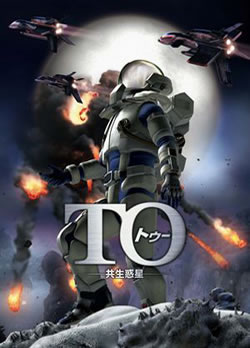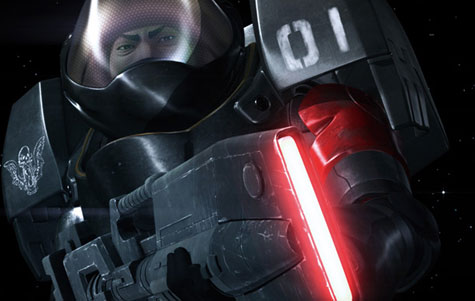If, like me, you first encountered anime in the 1990s then the chances are they were science fiction, fantasy and horror stories that first attracted your attention. In fact for decades that was what the medium was most strongly associated with—from the outside it seemed to be little more than cyborgs, giant robots, psychic teenagers, and city-leveling demons. In truth anime has always, since its first conception, covered a much wider range of topics and genres. Comedies, slice-of-life dramas and romances have always been popular, and over the last few years they have dwarfed everything else around them, with anime otaku seemingly more interested in cute girls and the intricacies of their daily life than any kind of more out of this world topics.
The countless debates, arguments and name-callings this has triggered within anime fandom are as tedious as they are endless, so I’ll move swiftly on here. But needless to say the lack of new productions has made being a science fiction or fantasy anime fan tough work at times. The good news is that things seem to be changing, and the ever trend-driven anime industry has started once again to look further afield. The last year has seen a flurry of new genre shows and movies, and in the first of a series of reviews I’m going to take a look at tone that has recently made the journey to U.S. (and U.K.) shores.

TO – 2001 Nights
To the uninitiated, the Japanese anime industry and the culture that surrounds it can seem perplexing at times, to say the least. In the west, when a film or TV show is released directly to video or DVD, it’s usually a sign of inferior quality or very limited market appeal. Or, in other words, it’s too shit to be shown at the cinema. Plus usually we’re talking about the sort of unoriginal, opportunist, unnecessary sequels that Disney were famous for churning out a decade or so ago. Jungle Book 2, anyone? God help us.
But in Japan, things are different. The market for anime was historically so strong, and anime fans so loyal and rabid in their spending that direct to video OVA (Original Video Animations) could make enough money to justify high budgets and risk taking concepts. Well, at least that’s the theory. TO – 2001 Nights is an OVA, and perhaps it demonstrates that things have changed.
After first coming to film-geeks attention with his excellent, cult live action comedy Ping Pong back in 2002, director and producer Fumihiko Sori took a slightly unexpected career path into CGI based anime production. The result was a rather lackluster string of movies—two new Appleseed adaptations and the mecha-thriller Vexille—all of which seemed to lack the emotional depth of not only Ping Pong but most hand-drawn anime.
TO sees Sori back in the director’s chair, as he takes on Yukinobu Hoshino’s critically acclaimed hard-SF manga series 2001 Nights. Heavily influenced by the seminal Kubrick film but set over several hundred years, the series took a look at mankind’s attempts to conquest space—from the first exploration of the solar system to the development of interstellar travel and the terraforming of other worlds. Sori has picked two stories from the tale-end of this period to adapt for TO, and I can’t help but think this was an unwise choice. While the earlier stories had a gritty, new-frontier edge to them, the later ones felt a little too comfortable in their technology, almost to the point of bordering on space opera. The result, in these two 35 minute CGI animations at least, feels sadly generic.
First up is Elliptical Orbit, the tale of legendary freighter The Flying Dutchman, which only returns to Earth every fifteen years. This time around it is carrying unobtainium liquid protons, a never at all explained but rare and miraculous power source that will solve all of Earth’s fuel problems. Unfortunately, as soon as it docks with a space station in Earth orbit it’s ambushed by a group of terrorists, planning to destroy it’s precious cargo. Their motivation for this is that they believe space exploration has been too much of a drain on the Earth, with the majority of the world’s population still stuck in poverty while an elite few explore the galaxy.
Now, this an interesting argument—enough so that not only has it been a common topic in science fiction for decades, but it was also the main topic of examination in Planetes—probably the greatest anime series yet made about humans in space, and an essential watch for any fan of sci-fi television. But here in EO it is just mentioned once, and then brushed away, to make room for ruthless, un-sympathetic, two-dimensional terrorists and courageous heroes. It feels like an awful waste of a chance to give the film some depth, but sadly zero-gee firefights and big explosions seem to be the order of the day. And to be fair it does a pretty good job with both of these, if again they do seem a little generic.

The second story, Symbiotic Planet, aims for a little more in the way of human depth. It’s a very recognizable Romeo and Juliet-style tale of two lovers working for rival superpowers trying to unlock the best way of terraforming a bizarre alien world. What makes this world unique is its ecosystem is based largely around spore type creatures that seem very simple at first, but in fact have a sophisticated, symbiotic relationship. Again this is a cool—if not vastly original—science fiction idea that should work as an easy metaphor for how we should all just get along (Avatar, anyone?) However things take a turn for the worse when there’s an outbreak of spores in one nation’s base, and the other uses it as an excuse to launch a military strike. Cue lots more explosions, firefights and sadly little else.
Symbiotic Planet certainly works better than Elliptical Orbit, but both share one crucial problem—the quality of the animation. There’s a certain amount of ‘uncanny valley’ syndrome as character faces seem lifeless at times, but as TO isn’t really striving for photorealism and is quite happy being a stylized animation, this isn’t really too much of an issue. No, the real problem is the animation of the character’s bodies and physical movements. I don’t know whether motion-capture was used, but I’m guessing probably not—if it was then the studio needs to find some less wooden actors. Everything just looks unconvincing, and to an avid anime watching even more jarring—one of the areas where the best traditional Japanese animators have historically excelled is in the convincing rendering of human movement. Instead everything feels a bit like a video game cut-scene—no, that’s unfair. Everything feels like a video game cut-scene from about 7 years ago.
I don’t want to be too dismissive of TO, because the truth is its heart is in the right place. It wants to be a serious, grown-up science fiction actioner, but sadly it feels like production problems might have upset the balance. I don’t know whether this was budget issues or studio interference, but either way it’s a shame. But not all is lost—if you enjoy CG animation and futuristic visuals there are far worse ways to spend 70 minutes; both episodes have some great mechanical and set design, and look great on Blu-ray. And for a lot of people that might—quite fairly—be enough.
A review copy was provided by the publisher.
Next time: brain-munching, panties-flashing fun with zombies!
Tim Maughan lives in Bristol in the U.K. and has been writing about anime and manga for nearly four years, and consuming both for over twenty. He also writes science fiction, and his debut book Paintwork, a collection of near-future short stories, is out now in print and for Kindle and all other eReaders. He also tweets way too much.










